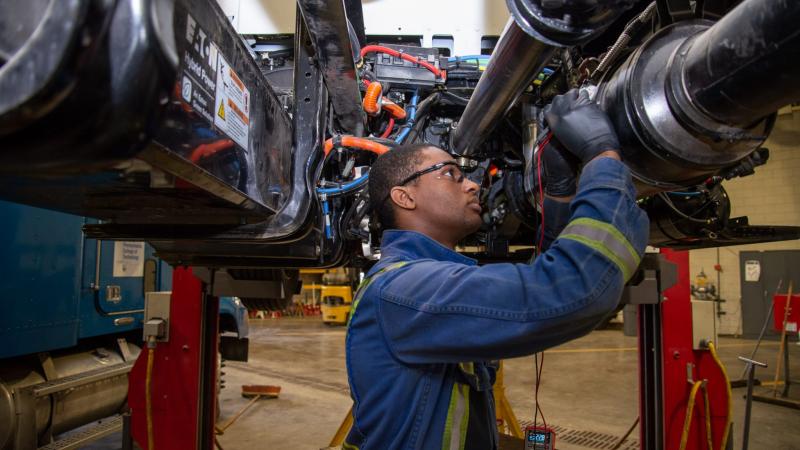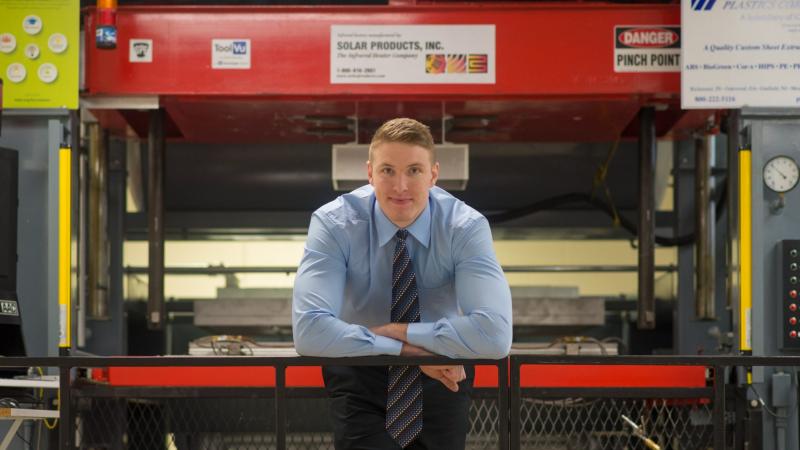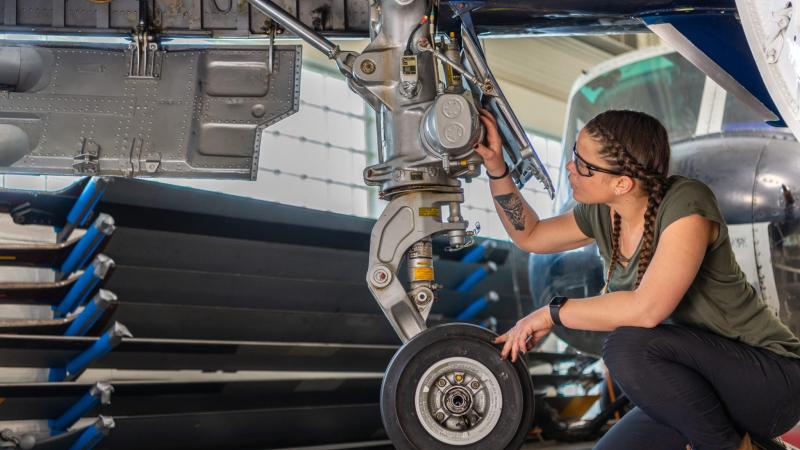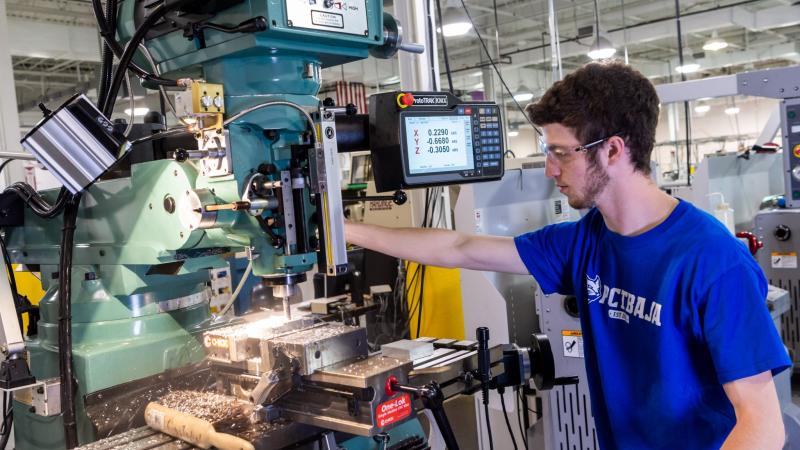Reclaiming STEM education
Published 02.14.2020

by Dr. Davie Jane Gilmour
President of the College
Understanding STEM
The ubiquitous acronym “STEM” has been around since 2001, though the educational and workforce concept it embodies harks back further.
Many trace its genesis to the late 1950s and to the space race that ensued when the former Soviet Union successfully launched Sputnik, the first artificial satellite, into Earth orbit, ushering in a bold new era of scientific and technological advancement.
Kudos, by the way, to biologist and academic administrator Judith Ramaley – director of the National Science Foundation’s education and human resources division when the term “STEM” was coined nearly two decades ago – for having the good sense (and ear) to suggest changing the original iteration of “SMET” to “STEM” – Science, Technology, Engineering, and Math.
But to hear the way that STEM is discussed – whether it be by thought leaders or by the media that covers them – one must forgive parents and students alike for believing that all these STEM fields require a half-dozen years of graduate school, or that a STEM career will mean spending every waking day alone in a laboratory. We in this room know better.
STEM careers don’t just refer to engineers and architects – the P.E.s and R.A.s of the world – but also to the surveyors, estimators and project managers, carpenters, HVAC technicians, and electricians who work as part of their team. They don’t just mean cardiothoracic surgeons, but the nurses, radiographers, surgical technologists, physical therapists, and others who are also responsible for successful outcomes. STEM careers can be found in fields as diverse as land management, power generation, cybersecurity, building controls, graphic design, automotive repair, and culinary systems.
As you may know, November 8 has been designated as “National STEM Day.” But at Pennsylvania College of Technology, where I have served as president for more than 20 years, we like to say that every day on our campus is STEM Day.
And when we market the College, we know we are being truthful with our prospective students when we tell them that STEM is more than a career path. It’s a way of thinking. It’s problem-solving. It’s demanding more from technology today, so that we can make an even bigger impact on tomorrow. STEM thinking is ingrained in our unique mission and approach to education. Really, you could say it’s imprinted on our DNA.
STEM at Penn College
For those of you who are unfamiliar with Penn College, we are an institution with roots tracing back to workforce-responsive vocational education that began more than a century ago at Williamsport High School. Since then, we have evolved from a technical institute, to a community college, to a special mission affiliate of Penn State offering more than 100 certificate, associate, baccalaureate, and graduate programs addressing the ever-changing needs of business and industry.
From Day One, our students acquire professional career skills in hands-on fashion in courses taught by faculty with relevant real-world work experience.
Instruction takes place in some pretty amazing facilities and labs featuring industry-standard equipment provided by industry-leading companies. A week ago, we unveiled a greatly expanded welding facility (the largest in higher education nationwide at 55,000-plus square feet) that can also lay claim to having the only electron beam welder in use in higher education in the U.S.
Business and industry representatives serve on our academic advisory committees, providing expert counsel on curriculum-related matters. And, when workforce cues tell us we need to change course with our expansive menu of academic offerings, we do so in a nimble fashion that must be the envy of many larger, and more bureaucratic, institutions.
It’s a time-tested instructional model that has enabled us to maintain an overall graduate-placement rate of 97.3 percent that reaches 100 percent for many majors. When we say we are “a national leader in applied technology education,” we can back up that assertion with testimonials from countless employers, who snap up as many of our job-ready graduates as they can while imploring us to turn out more. Sometimes, they don’t even wait for our students to complete their degrees before hiring them away – particularly true in professions like plastics and others plagued by skills-gap shortages.
Ours is a model that more and more colleges are choosing to emulate as they confront critical enrollment challenges prompted by shifting demographics and a declining pool of high school graduates that is projected to shrink even further as the new decade unfolds.
Making STEM Accessible
One of the distinct pleasures I derive from my position is meeting with parents who attend activities on campus. I’m always interested to hear why they chose Penn College. Over the past year or so, I and members of the College’s President’s Council have been surprised at times by some parents’ views regarding what a STEM education is and its suitability for their children.
Some have mentioned being deterred initially from investigating STEM careers, assuming they were strictly for aspiring physicians, engineers, researchers, and the like – careers that require those same types of professional credentials and/or board certifications/licensure following their names. And they want the people in this room to lead the charge in pitching a more inclusive portrayal of STEM to high school students and their families.
The classic misperception is that STEM careers must be too hard and not a good fit for most children. It got us thinking that the notion of STEM indeed may need to be reimagined, redefined, or simply communicated more effectively.
Faulty impressions about STEM are borne out by research. A recent PEW Research Center survey found that more than half of all adults (52%) believe students don’t pursue STEM careers because they think the subject matter will be too difficult.
As the PEW survey relates, “There is no single standard for which jobs count as STEM, and this may contribute to a number of misperceptions about who works in STEM and the difference that having a STEM-related degree can make in workers’ pocketbooks.”
For its purposes, PEW uses a broad definition of the STEM workforce based on 74 occupations classified in the U.S. Census Bureau’s American Community Survey, including computer and mathematical occupations, engineers and architects, physical scientists, life scientists, and health-related jobs such as healthcare practitioners and technicians. Included in this mix are workers with associate degrees and other credentials, in addition to those with bachelor’s degrees and advanced degrees.
Using this expanded definition, employment in STEM occupations has increased 79% from 1990 to 2016 and is growing faster than overall job growth nationwide. The PEW survey shows that, as of 2016, 17.3 million workers age 25 and older were employed in STEM occupations, representing 13% of the total U.S. workforce.
With PEW’s expanded STEM definition, about half of STEM workers are employed as health care practitioners and technicians, including nurses, physicians, and surgeons, as well as medical and health services managers. Computer workers (25%) and engineers and architects (16%) are the next best-represented groups.
Some other highlights from the PEW survey:
- STEM workers with some college education make 26% more than those in non-STEM career fields.
- For workers with master’s degrees, those in STEM fields show a 26% compensation advantage.
- STEM workers with a professional or doctoral degree earn 24% more than their non-STEM counterparts.
- 35% of STEM workers do not have a bachelor’s degree; 36% have a bachelor’s degree but no graduate degree; and 29% hold a master’s, doctorate, or professional degree.
- STEM training in college leads to higher compensation, whether the individuals wind up in STEM fields or not. Median earnings for full-time workers with a STEM college major are $81,011, compared with $60,828 for full-time workers graduating from non-STEM majors.
With data like this, you think it would be easy to get more teenagers interested in pursuing STEM careers, but obstacles remain. The website RecruitingDaily.com, noting forecasts showing that STEM occupations will be particularly hard hit by talent shortages in the coming years, cites multiple factors. An article on the website relates that students don’t see value in STEM careers, partly because it has not been communicated effectively to them by K-12 school systems or higher-education institutions.
“In many cases, younger generations – especially females – are losing interest in pursuing careers in STEM before reaching their teen years,” the article concludes.
The writer, Ben Weiner, also references a Randstad North America survey showing that “52% of students ages 11 to 17 don’t know anyone with a job in STEM.” The Randstad research also found that 76% of students in the 11-17 age group don’t know what engineers do in their jobs, and 50% don’t know what kind of math jobs exist. The same survey, however, found that “64% of students rated creating video games for a career, ‘very fun.’”
Changing Mindsets
Clearly, we as educators must do a better job of defining and sparking interest in STEM if we hope to mitigate the looming skills gap shortages that are being forecast. The oft-quoted study from Deloitte and The Manufacturing Institute found that more than half of the jobs predicted to be open in 2028 (as well as 3.5 million STEM jobs by 2025) could remain unfilled because of shifting skill sets, public misperceptions, and baby boomer retirements.
As the leader of a school renowned for its hands-on approach to learning, I should tell you that STEM-related misperceptions aren’t the only ones we confront. We continue to hear about certain occupations being “dirty jobs.”
But as anyone visiting our gleaming automated manufacturing or automotive technology labs can attest, that mindset is rooted in job practices that have ceased to exist in the largely computerized and automated workplace of 2020.
Looking at STEM occupational growth specifically in Pennsylvania, the state Department of Education predicts there will be 590,000 new and replacement jobs in Pennsylvania through 2026, with STEM jobs growing more than 9%.
Over the next 10 years, according to PDE, 71 percent of all new jobs will require computer science skills. Currently, there are more than 17,000 unfilled computer science and software development positions statewide – jobs with an average annual salary of $85,000.
PDE believes that all students are capable of STEM literacy, but success will depend upon a robust partnership among educators, students, families, postsecondary providers, legislators, and business and industry.
Aligning Education with Real Needs
At Penn College, we are doing our part. Using PEW’s STEM classification system, nearly the entire Penn College curriculum of 100-plus majors is represented. Most align directly, a few indirectly. Our STEM majors lead to solid careers in professions such as civil engineering, surveying, computer-aided drafting, building construction, HVAC, radiography, surgical technology, dental hygiene, nursing, physician assistant, automated manufacturing, mechatronics, electrical technology, information assurance and cybersecurity, gaming and simulation, plastics and polymers, welding, and automotive technology. I won’t read the entire list, but you certainly get the idea from this brief sample.
The wide-ranging menu should dispel parents’ – and students’ – concerns that there are no STEM majors to satisfy their needs or interests. Penn College’s STEM programs represent stimulating occupations and careers that also offer the promise of secure, lifelong employment.
The STEM program area with the largest enrollment at Penn College is information technology. So, when I reviewed a “Spotlight on Statistics” report from the U.S. Bureau of Labor Statistics, it came as no surprise to find that computer-based occupations lead all STEM-related career fields in projected new jobs through 2024, resulting in nearly a half-million new positions.
Engineering jobs are expected to add the second-largest number of new jobs. I should note: This report, unlike the PEW data on STEM that I referenced earlier, does not include most health care professions, again illustrating the fundamental need for standardization in STEM definitions and classifications.
The Role of Apprenticeships
I would be remiss if I failed to mention that STEM careers are also crucial to our apprenticeship offerings. Our Workforce Development unit is a national leader in apprenticeship training – both for incumbent workers and for Pre-Apprenticeship training designed for high school students, transitioning military personnel, and others.
In June 2019, Workforce Development was recognized for its comprehensive efforts to develop quality apprenticeships with a nearly $8 million award – over four years – for one of 23 federal grants to expand apprenticeships. Administered by Penn College and shared with our grant partner, New Jersey Institute of Technology, the MIDAS (or “Modular, Industry-Driven Apprenticeship Strategies”) grant will serve more than 3,200 apprentices.
MIDAS is focused on advanced manufacturing in occupations such as CNC, mechatronics, and plastics processing technician. MIDAS programs will also serve nontechnical topics like project management and supervisory skills.
The Penn College Pre-Apprenticeship model provides an overview of the foundational technical knowledge and skills in an industry sector. Pre-Apprenticeship is intended for those who are exploring a career path before entering employment or training.
Each Penn College Pre-Apprenticeship:
- Focuses on an industry sector with high demand for a skilled workforce.
- Aligns with an industry credential.
- Reinforces classroom learning with hands-on skill development.
- Groups pre-apprentices in a consortia, creating a supportive learning experience.
- Engages employers who offer potential employment and apprenticeship opportunities.
Each Penn College Pre-Apprenticeship is registered with the Pennsylvania Department of Labor & Industry and is aligned with a Penn College-registered apprenticeship program.
For example, the Penn College Advanced Manufacturing Pre-Apprenticeship Program is designed to increase knowledge of manufacturing concepts and skills and to expand the number of prospective employees choosing manufacturing-related career pathways. It teaches pre-apprentices foundation theory and hands-on skills to prepare them for many manufacturing occupations like CNC machinist, mechatronics maintenance worker, plastics process technician, or team lead.
The Pre-Apprenticeship program is designed for maximum flexibility. At schools providing little or no instruction in the related subject areas, students complete a larger number of computer modules to cover the required competencies. In schools with manufacturing instruction programs, computer modules supplement areas not covered existing curriculum. Customization is available for each school.
In November, we presented a Pre-Apprenticeship Summit, hosting scores of school administrators, counselors, and teachers who learned how to prepare today’s high school students for the in-demand, high-skilled careers of today and tomorrow.
A full agenda covered various facets of pre-apprenticeships – what they are, the benefits of integration into the secondary curriculum, and how they can pave a student’s path to college and career.
Honoring Our Youth
The educational landscape is changing fast, and it’s never too early for students and their families to begin exploring the exciting options available to them in this new environment. Careers based on changing and emerging technologies may be disconcerting to adults, but believe me, the Gen Z students we are courting now are not fazed. (I should interject here that the study by Deloitte and The Manufacturing Institute predicts that 47% of today’s jobs may simply vanish in the next decade, so workers’ willingness to adapt to new technology will be vital to success in the workforce.)
This reminds me of a full-page ad I saw in the New York Times – a rendition of the newspaper’s popular “The Truth is Hard” brand campaign featuring a specific message just for kids. The ad includes 19 lines that begin with the phrase “The truth is kids …” – addressing a variety of statements about children.
Some are particularly fitting in light of the rapidly evolving – and indelibly linked – spheres of technology, education, and work that we must balance moving forward.
Five of my favorites are:
- The truth is kids are more curious than many adults.
- The truth is kids learn something new every day.
- The truth is kids have big dreams.
- The truth is kids want to discover the world.
- The truth is kids will inherit the earth.
So how do we get to the essential truth about STEM education and how it will impact the next generation of learners whose dreams will shape our tomorrows?
What steps can each of your schools take to align students’ innate curiosity, dreams, desires, and passions with the STEM-related educational and career opportunities that await them?
How might partnerships with industry, and with institutions like Pennsylvania College of Technology, enable your school to reclaim STEM and position your students to help repair the skills gaps?




